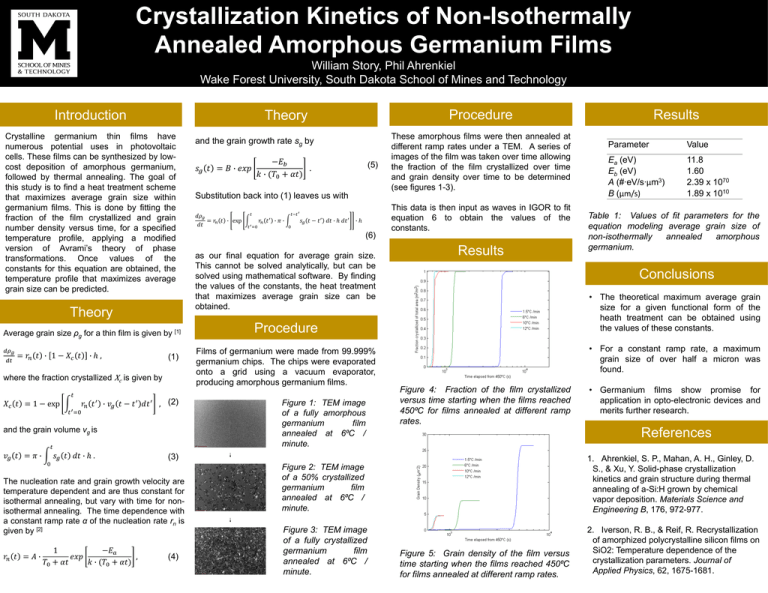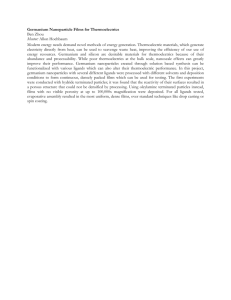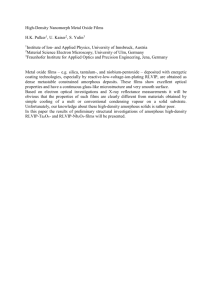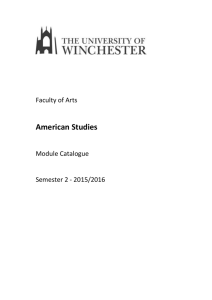Poster
advertisement

Crystallization Kinetics of Non-Isothermally Annealed Amorphous Germanium Films William Story, Phil Ahrenkiel Wake Forest University, South Dakota School of Mines and Technology Introduction Crystalline germanium thin films have numerous potential uses in photovoltaic cells. These films can be synthesized by lowcost deposition of amorphous germanium, followed by thermal annealing. The goal of this study is to find a heat treatment scheme that maximizes average grain size within germanium films. This is done by fitting the fraction of the film crystallized and grain number density versus time, for a specified temperature profile, applying a modified version of Avrami’s theory of phase transformations. Once values of the constants for this equation are obtained, the temperature profile that maximizes average grain size can be predicted. Theory Average grain size ρg for a thin film is given by [1] 𝑑𝜌𝑔 𝑑𝑡 = 𝑟𝑛 𝑡 ∙ 1 − 𝑋𝑐 𝑡 ∙ℎ, Procedure Theory (1) where the fraction crystallized Xc is given by and the grain growth rate sg by −𝐸𝑏 𝑠𝑔 𝑡 = 𝐵 ∙ 𝑒𝑥𝑝 . 𝑘 ∙ (𝑇0 + 𝛼𝑡) (5) Substitution back into (1) leaves us with 𝑑𝜌𝑔 = 𝑟𝑛 𝑡 ∙ exp 𝑑𝑡 𝑡−𝑡 ′ 𝑡 𝑡 ′ =0 𝑟𝑛 𝑡′ ∙𝜋∙ 𝑠𝑔 𝑡 − 𝑡′ 𝑑𝑡 ∙ ℎ 𝑑𝑡 ′ ∙ℎ 0 (6) as our final equation for average grain size. This cannot be solved analytically, but can be solved using mathematical software. By finding the values of the constants, the heat treatment that maximizes average grain size can be obtained. 𝑟𝑛 𝑡 ′ ∙ 𝑣𝑔 𝑡 − 𝑡 ′ 𝑑𝑡 ′ , (2) 𝑡 ′ =0 and the grain volume vg is 𝑡 𝑣𝑔 𝑡 = 𝜋 ∙ 𝑠𝑔 𝑡 𝑑𝑡 ∙ ℎ . Results Films of germanium were made from 99.999% germanium chips. The chips were evaporated onto a grid using a vacuum evaporator, producing amorphous germanium films. Figure 1: TEM image of a fully amorphous germanium film annealed at 6⁰C / minute. The nucleation rate and grain growth velocity are temperature dependent and are thus constant for isothermal annealing, but vary with time for nonisothermal annealing. The time dependence with a constant ramp rate α of the nucleation rate rn is given by [2] (4) Parameter Value Ea (eV) Eb (eV) A (#∙eV/s∙μm3) B (μm/s) 11.8 1.60 2.39 x 1070 1.89 x 1010 Table 1: Values of fit parameters for the equation modeling average grain size of non-isothermally annealed amorphous germanium. Conclusions • The theoretical maximum average grain size for a given functional form of the heath treatment can be obtained using the values of these constants. • For a constant ramp rate, a maximum grain size of over half a micron was found. Figure 4: Fraction of the film crystallized versus time starting when the films reached 450⁰C for films annealed at different ramp rates. • Germanium films show promise for application in opto-electronic devices and merits further research. References (3) 0 1 −𝐸𝑎 𝑟𝑛 𝑡 = 𝐴 ∙ 𝑒𝑥𝑝 , 𝑇0 + 𝛼𝑡 𝑘 ∙ (𝑇0 + 𝛼𝑡) This data is then input as waves in IGOR to fit equation 6 to obtain the values of the constants. Procedure 𝑡 𝑋𝑐 𝑡 = 1 − exp These amorphous films were then annealed at different ramp rates under a TEM. A series of images of the film was taken over time allowing the fraction of the film crystallized over time and grain density over time to be determined (see figures 1-3). Results Figure 2: TEM image of a 50% crystallized germanium film annealed at 6⁰C / minute. 1. Ahrenkiel, S. P., Mahan, A. H., Ginley, D. S., & Xu, Y. Solid-phase crystallization kinetics and grain structure during thermal annealing of a-Si:H grown by chemical vapor deposition. Materials Science and Engineering B, 176, 972-977. Figure 3: TEM image of a fully crystallized germanium film annealed at 6⁰C / minute. 2. Iverson, R. B., & Reif, R. Recrystallization of amorphized polycrystalline silicon films on SiO2: Temperature dependence of the crystallization parameters. Journal of Applied Physics, 62, 1675-1681. Figure 5: Grain density of the film versus time starting when the films reached 450⁰C for films annealed at different ramp rates.






